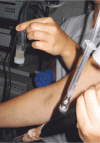Lower respiratory tract endoscopy in the cat: diagnostic approach to bronchial disease
- PMID: 24152702
- PMCID: PMC11383094
- DOI: 10.1177/1098612X13508253
Lower respiratory tract endoscopy in the cat: diagnostic approach to bronchial disease
Abstract
Practical relevance: Respiratory endoscopy is a useful diagnostic tool to evaluate the airways for the presence of mass lesions or foreign material while allowing for sample collection for cytologic and microbiologic assessment. While bronchial disease (eosinophilic or neutrophilic) is the most common lower respiratory disease identified in cats, infectious, anomalous and neoplastic conditions can clinically mimic inflammatory bronchial disease. Diagnostic imaging is unable to define the etiology for clinical signs of cough, tachypnea or respiratory difficulty, necessitating visual evaluation and collection of airway samples. Endoscopy allows intervention that can be life-saving and also confirmation of disease, which is important given that life-long medication is likely to be required for management of inflammatory airway disease.
Patient group: Cats with either airway or pulmonary disease benefit from laryngoscopy, tracheoscopy and bronchoscopy to determine an etiologic diagnosis. In the best situation, animals that require these procedures present early in the course of disease before clinical decompensation precludes anesthetic intervention. However, in some instances, these tests must be performed in unstable cats, which heightens the risk of the procedure. Cats that do not respond to empiric medical therapy can also benefit from bronchoscopic evaluation.
Clinical challenges: Due to the small size of feline airways and the tendency for cats to develop laryngospasm, passage of endoscopic equipment can be difficult. Bronchoconstriction can lead to hemoglobin desaturation with oxygen and respiratory compromise.
Evidence base: This article reviews published studies and case reports pertaining to the diagnostic approach to feline respiratory disease, focusing specifically on endoscopic examination of the lower airways in cats. It also discusses appropriate case selection, equipment, endoscopic techniques and visual findings based primarily on the authors' experiences.
Conflict of interest statement
The authors do not have any potential conflicts of interest to declare.
Figures

















References
-
- Hawkins EC, DeNicola DB, Kuehn NF. Bronchoalveolar lavage in the evaluation of pulmonary disease in the dog and cat. State of the art. J Vet Intern Med 1990; 4: 267–274. - PubMed
-
- Johnson LR, Vernau W. Bronchoscopic findings in 48 cats with spontaneous lower respiratory tract disease (2002–2009). J Vet Intern Med 2011; 25: 236–243. - PubMed
-
- Johnson LR, Drazenovich TL. Flexible bronchoscopy and bronchoalveolar lavage in 68 cats (2001–2006). J Vet Intern Med 2007; 21: 219–225. - PubMed
-
- Kirschvink N, Leemans J, Delvaux F, Snaps F, Clercx C, Gustin P. Bronchodilators in bronchoscopy-induced airflow limitation in allergen-sensitized cats. J Vet Intern Med 2005; 19: 161–167. - PubMed
Publication types
MeSH terms
LinkOut - more resources
Full Text Sources
Other Literature Sources
Medical
Miscellaneous

